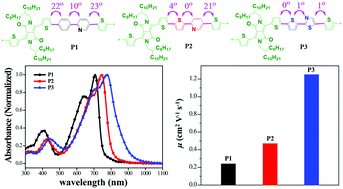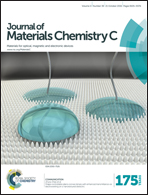The adjustment of bandgap and coplanarity of diketopyrrolopyrrole-based copolymers through fine-tuning of the conjugated backbones and applications in thin film field effect transistors†
Abstract
In order to demonstrate the influence of structural fine-tuning on bandgap and semiconductor performance of π-conjugated polymer materials, three new diketopyrrolopyrrole (DPP) based copolymers P1, P2 and P3 with monomers, i.e., 2-phenylpyridine, 2-(thiophen-2-yl)pyridine and 2-(thiophen-2-yl)thiazole, respectively, have been synthesized using a typical Suzuki cross-coupling polycondensation. The DFT calculations demonstrate that polymer P3 displays high backbone coplanarity in comparison to polymers P1 and P2. Absorption spectra results reveal that P3 exhibits a remarkable red-shifted absorption profile, narrow band gap and broad absorption. The thin film FET measurements show that P3 possesses the highest hole mobility (μh) up to 1.25 cm2 V−1 s−1 and on/off (Ion/off) ratio as high as 108. Those results demonstrate that the fine-tuning of the π-conjugated backbone can significantly affect the band gaps and coplanarities, and ultimately improve the semiconducting performances.


 Please wait while we load your content...
Please wait while we load your content...